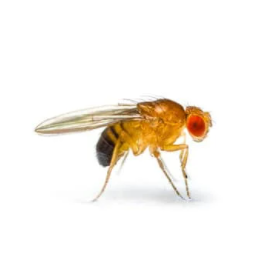Fruit flies are often thought of as an annoying pest. They are commonly found whizzing through the household, hovering above that bowl of brown bananas you swore you’d make banana bread from, and … in the lab? Here I will explain why they are one of science’s most useful model organisms and give you an insight into the kind of research these little beasties contribute to.
Drosophila melanogaster, otherwise, simply known as the fruit fly, are very commonly used in genetic, scientific, and medical research. They have been the tiny work force behind the research awarded Six Nobel prizes in physiology and medicine. This is largely because of their ease of laboratory use owed to their short generation time, high fecundity, and relatively simple genetics.
Because of their size, their bodies measuring no more than 3mm in length, fruit flies can be stored in great numbers. Hundreds of them can be seen crawling inside a single vial, laying eggs in their food; their young burrowing deep into the mush and then emerging, wandering larvae up the sides until they settle to form pupae. And so, it begins again. It sounds disgusting, I know. But the ability to contain this simple life cycle within a vial means that it is easily monitored, and fly stocks can be kept in labs for decades this way, by simply ‘flipping’ them into new food every month.
Despite the vast differences between you and that little fly, about 75% of the genes responsible for human diseases have homologs in the Drosophila. Meaning that they are widely used across genetic and neurogenerative research. Human genes and fly homologs can be modified to enable researchers to study the impact of specific genetic mutations. These mutations can be linked to physical appearances in the fly, including traits such as wing shape, eye colour and hair pattern, using balancers.
Fly genetics also make use of temperature. Did you know that you can slow down their development by placing flies at 18C? Special incubators allow fly researchers to finely control the speed at which new flies emerge and old flies age. In neurodegenerative research, disease genes are often associated to temperature-sensitive promotors which essentially “switch on” these genes to age the fly, when it is placed at 29C.

The fruit fly, Drosophila melanogaster, is used as a model organism to study disciplines ranging from fundamental genetics to the development of tissues and organs.
But what else can you do with a fly?
The lifespan can be studied to see if certain genetic mutations and interactions affect survival. In ALS/FTD research they are used in climbing assays to assess motor ability. Flies are anaesthetised with CO2 and gathered into empty tubes marked with pen lines at 1cm intervals. The tubes are tipped to ‘reset’ the flies and then the test begins. A stopwatch is started as flies start to climb up the tube, the markings are used to measure the distance climbed per fly in 20-seconds. This experiment takes advantage of the fly’s negative geotaxis – their natural ability to orientate themselves against gravity. This innate upward climbing behaviour is a great tool for measuring motor ability in flies with genetic mutations associated with ALS, and other movement disorders.
But there’s more! In epilepsy research, you can induce seizures and monitor duration and recovery time in the fly. In pain research you can use heat plates to monitor stimulus aversion. Using assays like DART (Drosophila ARousal Threshold) you can research the startle response and sleep defects in mutants. And in addiction research, flies can show addictive traits towards alcohol consumption.
But beyond behavioural experiments, flies are a great alternative to other protected animals for experiments which are more invasive. Fly brain dissection is a great way to visualise changes in the brain in vivo, with anatomical assessments such as cell nuclear circularity and protein localisation possible with the help of GFP genetics and fluorescent antibodies.
As you can imagine, fruit flies are small. With their brains no bigger than a poppy seed containing just 100,000 neurons, they bring a whole new meaning to the phrase ‘small-minded’. Therefore, this type of brain surgery is known as micro dissection and is carried out using a microscope, sharp forceps, and a steady hand. Holding under the probiscis, one set of forceps stabilises the head while the other removes the eyes (taking great care not to pierce them as the orange pigment will cloud your dissecting medium, obscuring your view). And you should be left with an intact brain – two optical lobes and a central brain. It can take some practice to get this right, but experienced researchers can do many a minute.
These are just a few examples of the ways the fruit fly is used in the lab, so next time you see one hovering above the bowl of bananas, be sure to thank it for its contribution to science.

Jodi Parslow
Author
Jodi Parslow [1] is a MRC-DTP Doctoral Researcher at King’s College London researching Neuron-glia signalling and neuroinflammation in neurodegenerative disease. Jodi started her career as a Nursing Assistant, that led her to Neuroscience at University of Sussex, then on to a Masters and into industry working for a wearables technology company. Finally Jodi brought her skills and passion together to work in dementia research, first as a Research Technician and now as a PhD Student. Jodi loves talking about her work and science, and also has her own podcast ‘The Academinist’ [2].
Follow on Instagram @NotBrainScience [4]